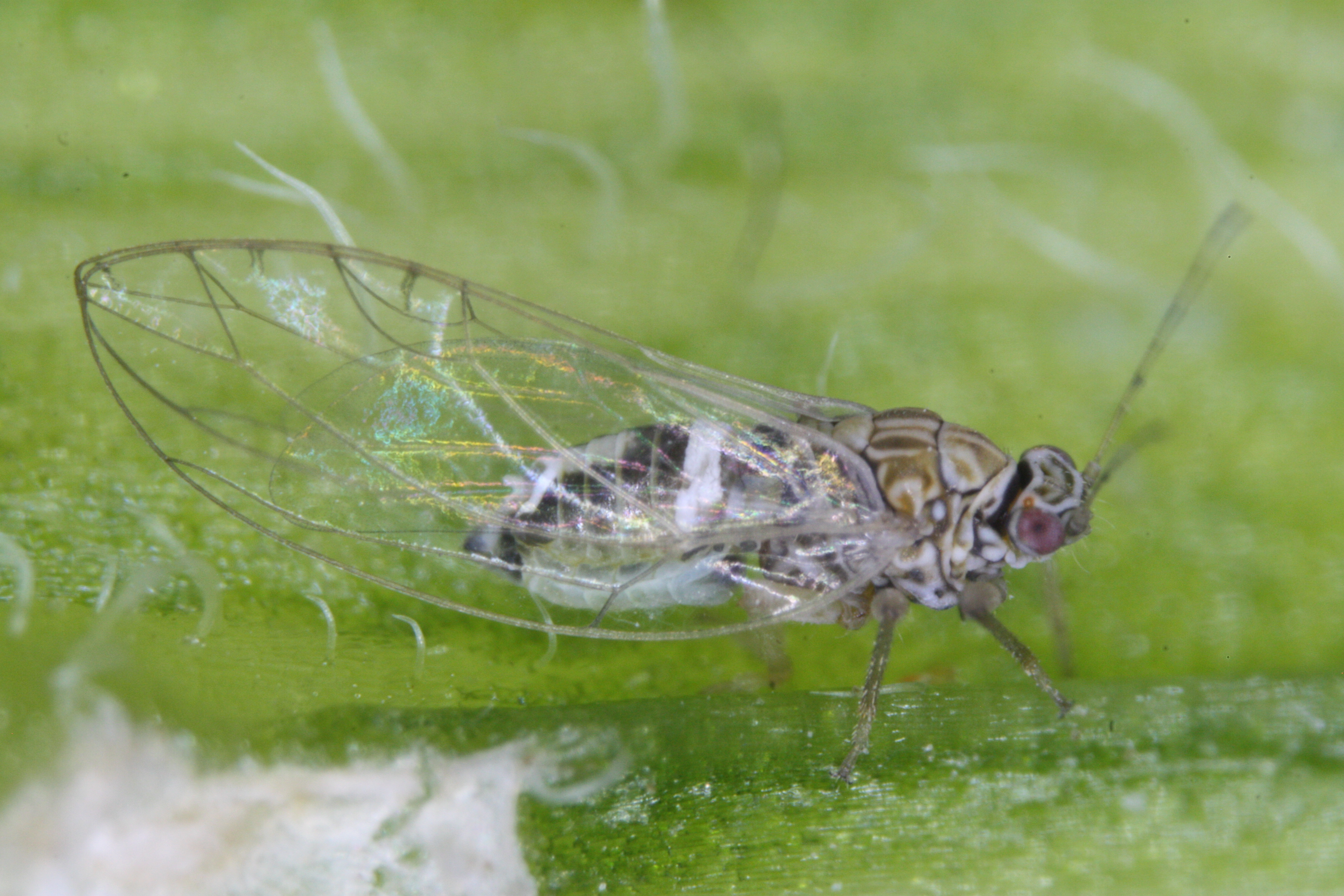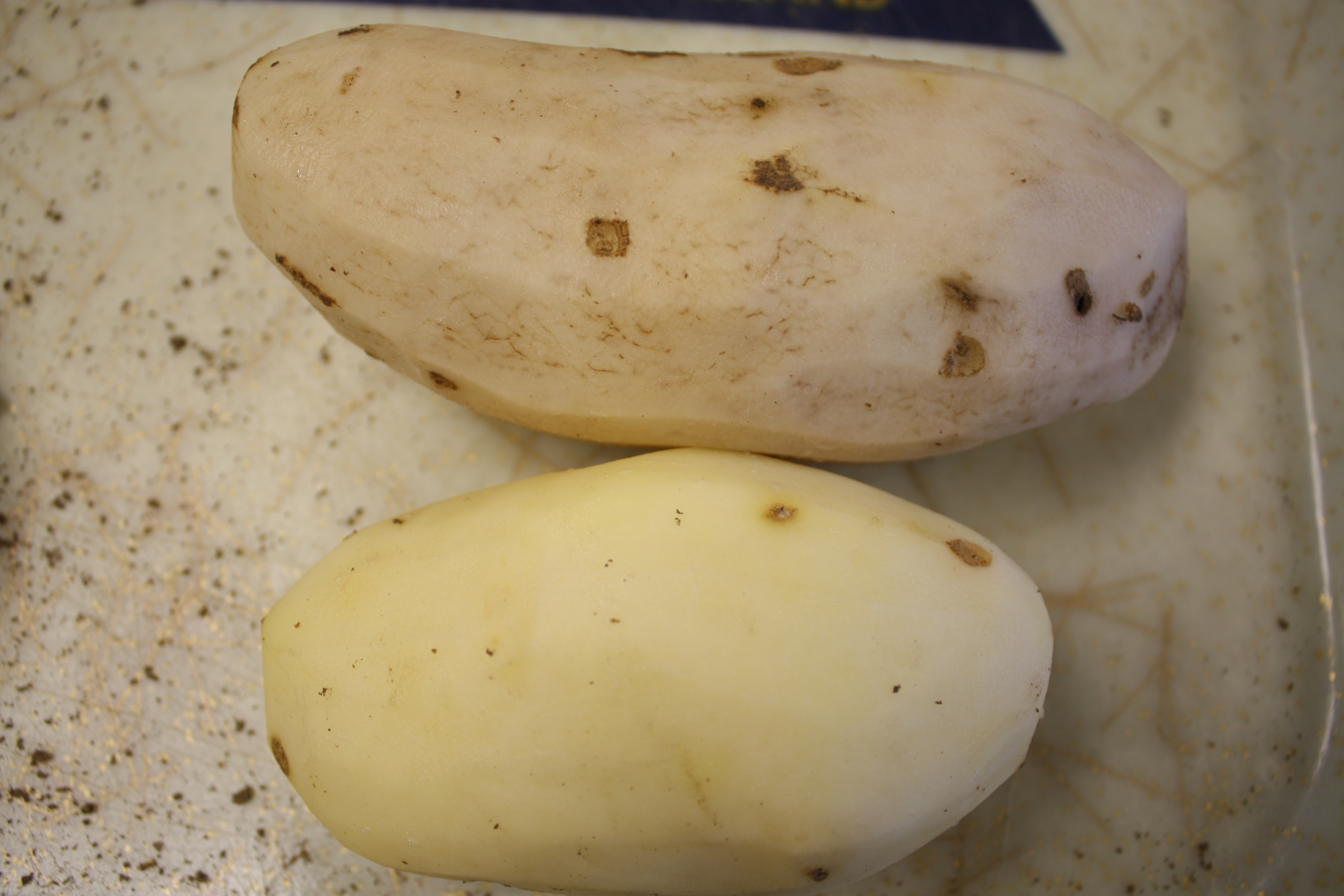Ever since zebra chip disease was first reported in Idaho, Washington and Oregon in 2011, we have been interested in monitoring the potato psyllid—a small insect that transmits the bacterium associated with zebra chip. This disease causes plants to produce tubers with striped necrotic patterns that make them unmarketable. Tracking potato psyllids over the season can help growers make decisions on when and where to apply insecticides to manage the vector and the disease.
 Several different sampling methods have been explored over the years, but for the most part, researchers and growers have been sticking with yellow sticky traps for monitoring adult potato psyllids in potato crops. In fact, sticky trap monitoring has recently been made a requirement for Pacific Northwest growers planning to export table-stock potatoes to South Korea.
Several different sampling methods have been explored over the years, but for the most part, researchers and growers have been sticking with yellow sticky traps for monitoring adult potato psyllids in potato crops. In fact, sticky trap monitoring has recently been made a requirement for Pacific Northwest growers planning to export table-stock potatoes to South Korea.
Yellow sticky traps offer a useful approach to monitoring potato psyllids; however, there are some important considerations that can help in getting the most out of your sticky traps. We have been monitoring psyllids across southern Idaho since 2012, and here I offer some tips on using yellow sticky traps for monitoring potato psyllids in your potato fields.
The materials needed include yellow sticky traps, of course, but also wooden stakes, large binder clips and a permanent marker to label the traps. We use 4×6-inch yellow sticky traps, which are offered by a number of different companies. We make our own stakes using wood lath, which can be purchased from a home center; one end of each lath can be cut to a point to turn it into a stake. The binder clip is used to secure the sticky trap on the stake.
Before deploying in the field, each sticky trap should be labeled with as much detail as is needed to later identify where it came from. This likely will include the field name, date and location in the field. At a minimum, each field should have a trap placed in four locations evenly spaced around the perimeter of the field—typically one at each cardinal direction. More traps are necessary for larger fields.
Traps should be placed within fields, about 10 feet from the edge of the field, oriented perpendicular to the stake with one face of the trap facing toward the edge of the field. This should facilitate capturing psyllids as they fly into the field from the field edge.
 Both sides of the trap have a piece of wax paper that is removed to expose the sticky part of the trap. These sheets of wax paper need to be saved for later retrieval of the traps.
Both sides of the trap have a piece of wax paper that is removed to expose the sticky part of the trap. These sheets of wax paper need to be saved for later retrieval of the traps.
The sticky trap should be positioned on the stake just above the potato canopy. Too low, and the foliage will cover the trap; too high, and you may miss psyllids that are attempting to land on the foliage. Traps often need to be positioned slightly above the canopy to compensate for vigorous growth during some parts of the season. Of course, when plants are senescing at the end of the season, the traps need to be moved to a lower position on the stake to stay just above the crop canopy.
You remembered to save the wax paper that you peeled off the new sticky traps, right? Good. We use this wax paper to cover both sides of each trap as we retrieve them from the field. The insects and debris collected on the trap typically allow the paper to stick well enough that it remains in place, allowing you to stack a set of traps together without them sticking to each other (or to you).
It is very important to remember that this wax paper has a waxy side and a not-so-waxy side. If you stick the less waxy side to the sticky trap, you generally can forget about ever removing it again. Make sure you place the wax paper with the waxy face on the sticky trap so that the paper can be removed later to reveal the insects on the trap.
Each sticky trap should be swapped out for a new one every week. Changing out sticky traps on the same day every week is ideal. Traps from the same field can be bundled together with rubber bands or in a zipper closure bag, and they should be stored in a freezer when possible. The date that each group of traps was retrieved should be clearly written on each set of traps from each field.
Now that you have succeeded in sending your sticky traps out into the world and returning them home safely, the next step is to inspect them for potato psyllids. Unfortunately, this is no easy task. You will need magnification—ideally a dissecting microscope, but a 15× or 20× hand lens can work. There are several key characteristics to look for, and Andy Jensen, manager of the Northwest Potato Research Consortium, produced a helpful guide to identifying potato psyllids on yellow sticky traps that can be found at www.nwpotatoresearch.com/resources/insect-trapping-guides.
Alternatively, the entomology program at University of Idaho in Kimberly is offering psyllid identification as a fee-for-service arrangement for Idaho growers. For a per-trap fee, we can supply the yellow sticky trap system that growers then deploy, retrieve and return to the research station in Kimberly each week. We will identify and count any potato psyllids and send them to the University of Idaho diagnostics lab in Parma to test for the presence of the zebra chip bacterium (This testing requires a separate fee.). We can then provide you with a weekly report of our findings.
Erik J. Wenninger is an entomologist at the University of Idaho’s Kimberly Research & Extension Center. Idaho growers interested in the services detailed in this article can contact Wenninger at (208) 423-6677 or erikw@uidaho.edu.